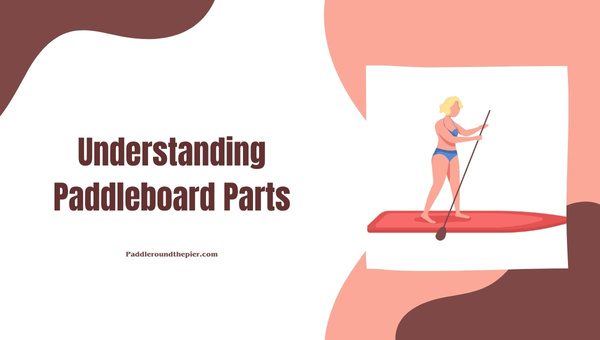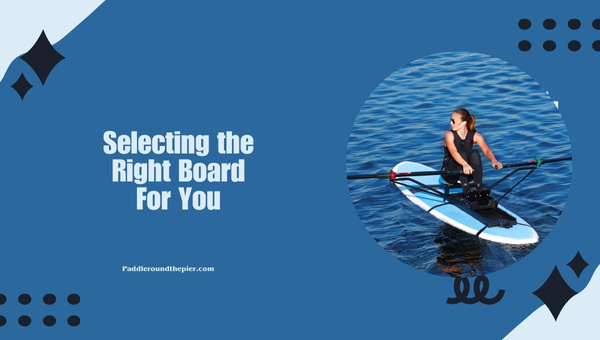Paddleboard Parts: Your Guide to Essential Components
One thing is for sure; understanding paddleboard parts will enhance your boarding experience incredibly. Whether you're a novice or an experienced stand-up paddleboarder, knowing your board inside and out can make a world of difference. This handy guide walks you through the essential parts of a paddleboard and its function so you can get the most out of your time on the water.
Paddleboard parts differ from board to board, but there are key elements that remain consistent across all designs. These include the board itself, nose, tail, deck pad, handles, and fins. Understanding how these components work together shapes not only how you ride but also impacts performance and stability.
Understanding Paddleboard Parts
In the world of watersports, paddleboarding stands out as a relaxing yet challenging activity. Knowing your board well can have a significant impact on your experience, and that's where understanding paddleboard parts comes in.

Key Components
When I look at my board before hitting the water waves early in the morning, I usually start from one end to another just like reading my favorite book:
- Note: At the very front of any paddleboard you'll find the nose - this design aspect influences how smooth my ride will be depending upon wave conditions.
- Tail: Just like everything else in life you have two ends! On the opposite side of your nose is tail keeps me afloat while turning or changing direction.
- Deck Pad: For beginners especially - a deck pad (a cushioned area) provides immense support for maintaining balance. Not to mention relief for those sore feet during long sessions!
- Fins: These little buddies underneath may appear insignificant but they're crucial for maneuverability and stability.
- Rails: The sides of the paddleboard that help maintain balance and are key for turns and cuts.
Next time you step on your paddleboard, you'll realize it's not just a slab of foam or fiberglass - it's an intricate piece of craftsmanship with many essential elements. And it is these vital components that contribute to your paddling experience.
Let's take a dive into these details to better comprehend our faithful partner in water.
Also Read: Kayaking in Hilton Head Islands: Ultimate Adventure Guide
Essential Paddleboard Parts
When it comes to understanding the components that make up a SUP board or a paddleboard, there are several key elements. From the basic board structure to customized add-ons for specific needs, every detail plays a crucial role in ensuring an optimal paddleboarding experience.
The Board
The main component of any setup is undeniably the paddle board itself. Whether you prefer a rigid hardboard or an inflatable model, understanding the materials and construction can help enhance your time on the water.
- Materials: Different types of materials are employed based on whether your board is inflatable or hard. Softer materials such as PVC and drop-stitch construction typically form inflatable models, while hardboards often feature foam core layers with fiberglass and epoxy resin exteriors.
- Size considerations: There's more to sizing than just length. Alongside this, you also need to consider width, thickness, and volume – all of which affect stability and performance. For instance:
- Length: Boards usually range from 9 feet all the way up to 14 feet depending on intended use (waves vs flatwater paddling).
- Width: To gauge stability; wider boards are generally more stable.
- Thickness & Volume: These dictate how much weight your SUP can support without affecting performance.
Being aware of these essential paddleboard parts will aid you in selecting the perfect board for your unique needs.
The Fins
When discussing key SUP board elements, fins unquestionably deserve a mention. They profoundly influence maneuverability and tracking (the ability for straight-line motion).
There exist different styles of fins based on their number:
- Single fin setup: Widely incorporated in SUP boards designed for flat water racing due to their excellent straight-line tracking capabilities.
- Three-fin setup (or Thruster): Boosts maneuverability making them ideal for surf conditions.
- Quad-fin setup: Superb for carving tight turns in wave riding.
It's worth noting that detachable fins provide convenience and versatility as you can swap them based on the water conditions you'll be paddling in.
The Deck Pad & Handles
Though potentially underappreciated, deck pads and handles make up a significant part of a paddle board's anatomy. They govern comfort, control, and transportability.
- Deck Pads: These offer traction and comfort during your paddleboarding sessions. Look out for features like a contoured arch (for back foot support), cocktails (for surfing prowess), or diamond-grooved patterns (extra grip while paddling).
- Handles: Mainly used to carry your board from place to place, some boards feature multiple handles for easy maneuverability, while others may have recessed handles not to interfere with movement when you're onboard.
By understanding these parts in depth, one gains more confidence and control over their SUP board while out on the water.
Also Read: Cost of Paddle Board: Detailed Guide to Your Purchase
Details About Additional Paddleboard Parts
After understanding the essential paddleboard parts, we need to turn our attention to some often-overlooked components that can significantly improve your paddling experience. Let's dive into two crucial elements: the leash or detachable seat and the all-important paddle.
Leash/Detachable Seat
You might wonder what a leash or detachable seat has to do with SUP board components. Well, they are not core elements of a paddleboard’s anatomy but can be incredibly beneficial depending on your usage:
- SUP Leash: A stand-up paddleboard leash is like a super long, stretchy rubber band attached at one end to the tail of your board and the other around your ankle. This lifesaver device ensures that even if you lose balance and fall into the water, you won't lose your board since it will remain tethered to you.
- Detachable Seat: As much as standing up on the paddleboard contributes to the whole SUP adventure, there may be moments when you want to rest or sit while remaining on the water. Hence, this is where a detachable seat comes in handy! These seats allow for greater comfort during long paddles or when fishing from your board.
The Paddle
When we think about key SUP board elements, we often overlook one major piece —the paddle— yet it is indeed an indispensable part of paddleboarding! Here's why:
- Length Adjustment: The length of your paddle plays an essential role in how effective and efficient your paddling strokes will be. To adjust correctly based on height: Stand straight and extend an arm above you; for optimal fitment, select a paddle that reaches up right till your wrist.
- Paddle Blade Size & Shape: Just like fins impact how smoothly you cut through water currents so too does blade size & shape affect each stroke's power.
- Material Type: The paddle material will affect its weight and durability. While those made from aluminum or plastic are more affordable, they are heavier. On the other hand, carbon or fiberglass paddles are lighter and easier to handle but come at a higher price point.
Understanding the nuances of these paddleboard parts can make your SUP adventure even more exciting! So whether you're riding waves or exploring calm waterways, every piece of your paddle board's anatomy contributes to your overall experience on the water.
Also Read: SUP with Dog Guide: Unleashing Fun on the Waterways
Selecting the Right Board For You
Paddleboarding can turn into a magnificent pastime if you have just the right board for your body type and skill level. Understanding how these two factors influence your control and enjoyment out on the water can help improve your overall paddleboarding experience.

Body Type/Experience Level Consideration
Choosing a paddleboard to match your physical attributes and experience level isn’t merely about color selections or designs printed on them; it's about making an informed choice that aids in maximizing comfort, stability, and performance.
- Body Weight - Your weight is one of the significant determining factors when choosing a board. For instance, if you're heavier than average, search for SUP boards with higher volume ratings (indicative of adequate flotation). Conversely, lighter individuals might prefer narrower boards as they'll sit higher on water hence easier maneuverability.
- Height - Taller individuals generally need longer paddles, while shorter ones will do well with paddles around their chest height when standing upright. Getting this right may affect posturing and efficiency when propelling yourself forward.
- Experience Level - Beginners might want to consider wider "all-around" boards that offer greater stability compared to narrower racing or touring boards designed for experienced riders willing to sacrifice some stability in favor of speed or performance.
- All-Around Boards: Best for beginners as they are wide and stable allowing easy balance while learning.
- Racing Boards: Designed with speed in mind; they have pointed noses cutting through water efficiently - suitable for advanced/experienced riders.
- Yoga Boards: These are wide yet less buoyant providing perfect balance & ample space essential during yoga workouts.
Personal skills shouldn't be overlooked either: if you're new or nervous around water bodies, consider sticking to flat-water riding until you build confidence over time as opposed to immediate surfing paddleboards which demand more skill and experience.
Unfamiliar waters or intermediate riders might want to consider an "all-around" board that can handle different conditions satisfactorily without compromising much on speed or performance.
Seasoned paddleboarders, on the other hand, will appreciate a "touring" or "racing" board, which offers increases in speed and responsiveness but requires adept skills.
FAQs
What are the types of paddleboards, and which is best for a beginner?
There are several types of paddleboards including all-around boards, touring boards, fishing boards, surfing boards, and yoga boards. Generally, all-around or multi-purpose boards are ideal for beginners due to their stability and versatility.
What is the purpose of having multiple fins on a paddleboard?
Having multiple fins on a paddleboard enhances maneuverability and provides better tracking abilities. They also stabilize the board against side winds and currents thereby ensuring a smoother ride.
Why do some paddleboards have different shapes and sizes?
Different shapes and sizes have different purposes in paddleboarding. Wider boards offer more stability but may be slower, longer ones glide more effectively in long distances while shorter ones provide agility for wave riding or river-running. The choice largely depends on one's paddling style preference or your specific activity goal on water.
Conclusion
Understanding the anatomy of your equipment is key to mastering any sport, and paddleboarding is no exception. The different parts of a paddleboard contribute to how it performs and adapting it to suit your specific needs can help enhance your experience on the water.
Furthermore, familiarizing yourself with the various paddleboard parts provides you with comprehensive knowledge that aids in making an informed choice when selecting a board that caters to your body type and experience level.
Key Takeaway Points
- Grasping the overall design and structure of a paddleboard, including its crucial components, is vital.
- Essential paddleboard parts such as the board, fins, deck pad & handles play significant roles in comfort and performance.
- Optional SUP board components like leashes or detachable seats add versatility.
- The selection of paddleboards should be informed by personal considerations like body type or experience level.
